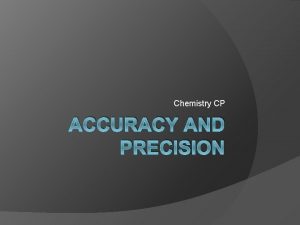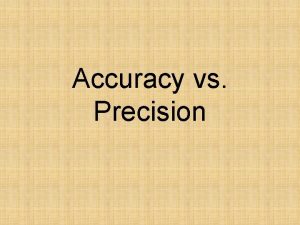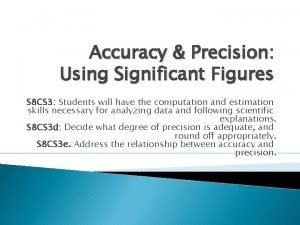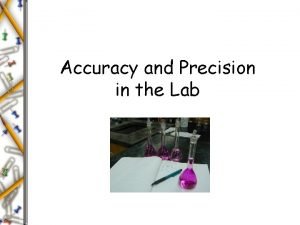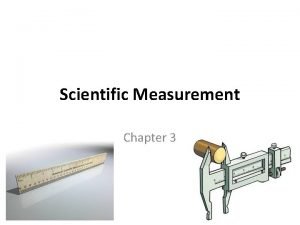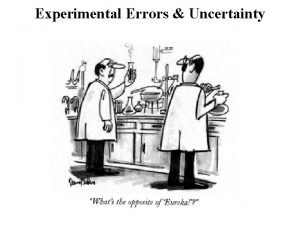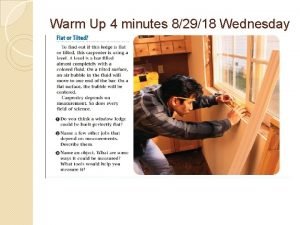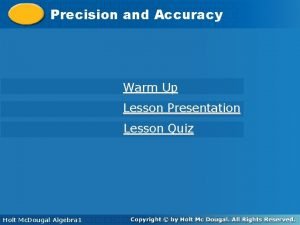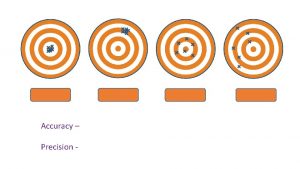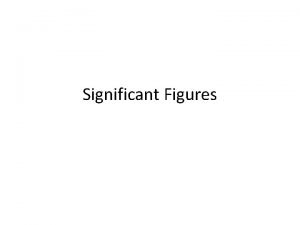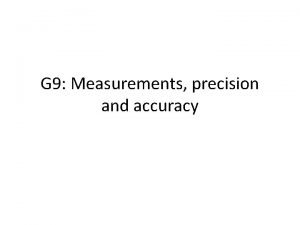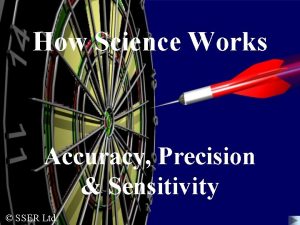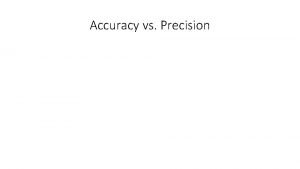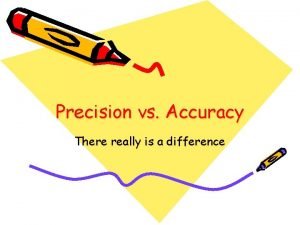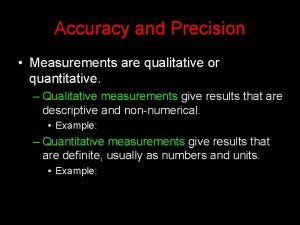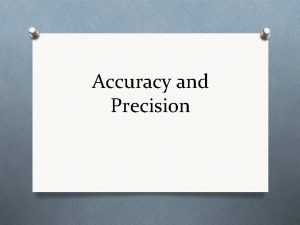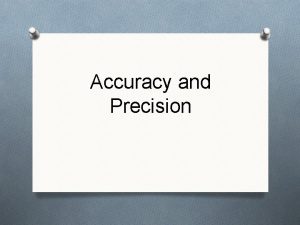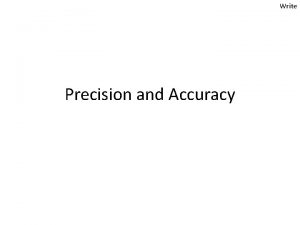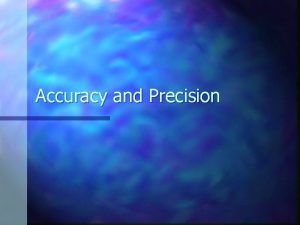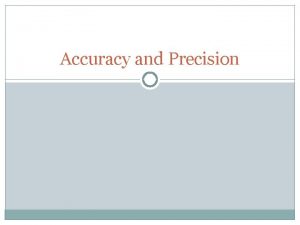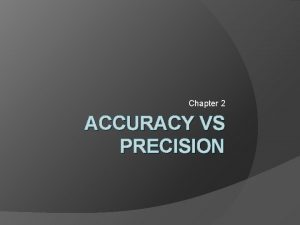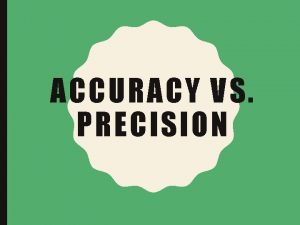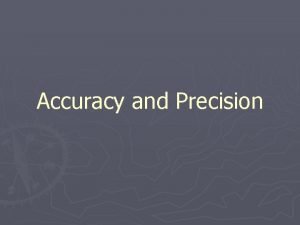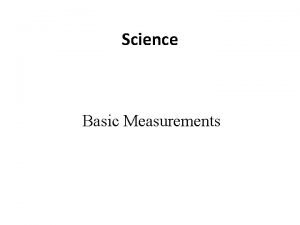Precision and Accuracy The same thing Precision A




















- Slides: 20

Precision and Accuracy The same thing?

Precision A student’s height was measured several times using a laser device. All the measurements were very similar and the height was found to be 184. 34 ± 0. 01 cm This is a precise result (high number of significant figures, small range of measurements)

Accuracy Height of Student= 184. 34 ± 0. 01 cm This is a precise result, but not accurate (near the “real value”) because the man still had his shoes on.

Accuracy The student then took his shoes off and his height was measured using a ruler to the nearest centimetre. Height = 182 ± 1 cm This is accurate (near the real value) but not precise (only 3 significant figures)

Precise and accurate The student’s height was then measured without his socks on using the laser device. Height = 182. 23 ± 0. 01 cm This is precise (high number of significant figures) AND accurate (near the real value)

Precision vs Accuracy

Random errors/uncertainties Some measurements do vary randomly. Some are bigger than the actual/real value, some are smaller. This is called a random uncertainty. Finding an average can produce a more reliable result in this case.

Systematic/zero errors Sometimes all measurements are bigger or smaller than they should be. This is called a systematic error/uncertainty.

Systematic/zero errors This is normally caused by not measuring from zero. For example when you all measured Mr Fong’s height without taking his shoes off! For this reason they are also known as zero errors/uncertainties. Finding an average doesn’t help.

Systematic/zero errors Systematic errors are sometimes hard to identify and eradicate.

Uncertainties In measuring a table in the classroom, we found the length of the table to be 1563 ± 5 mm We say the absolute uncertainty is 5 mm The fractional uncertainty is 5/1563 = 0. 003 The percentage uncertainty is 5/1563 x 100 = 0. 3%

Uncertainties If the average height of students at Glenforest is 1. 23 ± 0. 01 m We say the absolute uncertainty is 0. 01 m The fractional uncertainty is 0. 01/1. 23 = 0. 008 The percentage uncertainty is 0. 01/1. 23 x 100 = 0. 8%

Combining uncertainties When we find the volume of a block, we have to multiply the length by the width by the height. Because each measurement has an uncertainty, the uncertainty increases when we multiply the measurements together.

Combining uncertainties When multiplying (or dividing) quantities, to find the resultant uncertainty we have to add the percentage uncertainties of the quantities we are multiplying.

Combining uncertainties Example: A block has a length of 10. 0 ± 0. 1 cm, width 5. 0 ± 0. 1 cm and height 6. 0 ± 0. 1 cm. Volume = 10. 0 x 5. 0 x 6. 0 = 300 cm 3 % uncertainty in length = 0. 1/10 x 100 = 1% % uncertainty in width = 0. 1/5 x 100 = 2 % % uncertainty in height = 0. 1/6 x 100 = 1. 7 % Uncertainty in volume = 1% + 2% + 1. 7% = 4. 7% (4. 7% of 300 = 14) Volume = 300 ± 14 cm 3 This means the actual volume could be anywhere between 286 and 314 cm 3

Combining uncertainties When adding (or subtracting) quantities, to find the resultant uncertainty we have to add the absolute uncertainties of the quantities we are multiplying.

Combining uncertainties One basketball player has a height of 216 ± 1 cm and the other has a height of 172 ± 1 cm. What is the difference in their heights? Difference = 44 ± 2 cm

Who’s going to win? Toronto Star Latest opinion poll Hudak 48% Mc. Guinty 52% Mc. Guinty will win! Uncertainty = ± 5%

Who’s going to win? Toronto Star Latest opinion poll Hudak 48% Mc. Guinty 52% Mc. Guinty will win! Uncertainty = ± 5%

Who’s going to win? Hudak = 48 ± 5 % = between 43 and 53 % Mc. Guinty= 52 ± 5 % = between 47 and 57 % We can’t say! (If the uncertainty is greater than the difference)
 Accurate vs precise chemistry
Accurate vs precise chemistry Difference accuracy and precision
Difference accuracy and precision Accuracy, precision, and significant figures worksheet
Accuracy, precision, and significant figures worksheet Multiplication of uncertainty
Multiplication of uncertainty Poor accuracy good precision
Poor accuracy good precision Quick lab accuracy and precision answers
Quick lab accuracy and precision answers Experimental error definition
Experimental error definition Brainpop precision and accuracy quiz answers
Brainpop precision and accuracy quiz answers Precision meaning in physics
Precision meaning in physics Active and passive instruments examples
Active and passive instruments examples Precision and accuracy
Precision and accuracy 1-10 practice precision and accuracy
1-10 practice precision and accuracy Accuracy and precision
Accuracy and precision Precision and accuracy
Precision and accuracy Brainpop mindfulness quiz answers
Brainpop mindfulness quiz answers Sensitivity accuracy precision
Sensitivity accuracy precision Precision vs accuracy science
Precision vs accuracy science Precision vs accuracy chemistry
Precision vs accuracy chemistry Precision of measurement depends on *
Precision of measurement depends on * Pmi quality management
Pmi quality management Significant figures
Significant figures
